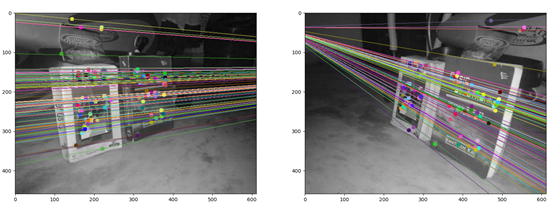OpenCV中的对极几何
在上个教程中我们已经简述了对极几何的一些理论知识,本次我们来使用OpenCV中的一些函数来进行实战,为了得到基础矩阵我们应该在两幅图像中找到尽量多的匹配点。我们可以使用 SIFT 描述符,FLANN 匹配器和比值检测。
我们使用示例图片:


先看代码:
import numpy as np
import cv2 as cv
from matplotlib import pyplot as plt
img1 = cv.imread('myleft.jpg', 0) # queryimage # left image
img2 = cv.imread('myright.jpg', 0) # trainimage # right image
sift = cv.xfeatures2d.SIFT_create()
# find the keypoints and descriptors with SIFT
kp1, des1 = sift.detectAndCompute(img1, None)
kp2, des2 = sift.detectAndCompute(img2, None)
# FLANN parameters
FLANN_INDEX_KDTREE = 1
index_params = dict(algorithm=FLANN_INDEX_KDTREE, trees=5)
search_params = dict(checks=50)
flann = cv.FlannBasedMatcher(index_params, search_params)
matches = flann.knnMatch(des1, des2, k=2)
good = []
pts1 = []
pts2 = []
# ratio test as per Lowe's paper
for i, (m, n) in enumerate(matches):
if m.distance < 0.8*n.distance:
good.append(m)
pts2.append(kp2[m.trainIdx].pt)
pts1.append(kp1[m.queryIdx].pt)现在得到了一个匹配点列表,我们就可以使用它来计算基础矩阵了。
retval, mask=cv.findFundamentalMat(points1, points2, method, ransacReprojThreshold, confidence, mask)
· points1:从第一张图片开始的N个点的数组。点坐标应该是浮点数(单精度或双精度)。
· points2:与点1大小和格式相同的第二图像点的数组。
· method:计算基本矩阵的方法。
· cv2.FM_7POINT for a 7-point algorithm. N=7
· cv2.FM_8POINT for an 8-point algorithm. N≥8
· cv2.FM_RANSAC (默认) for the RANSAC algorithm. N≥8
· cv2.FM_LMEDS for the LMedS algorithm. N≥8
· ransacReprojThreshold:仅用于RANSAC方法的参数,默认3。它是一个点到极线的最大距离(以像素为单位),超过这个点就被认为是一个离群点,不用于计算最终的基本矩阵。根据点定位、图像分辨率和图像噪声的准确性,可以将其设置为1-3左右。
· confidence:仅用于RANSAC和LMedS方法的参数,默认0.99。它指定了一个理想的置信水平(概率),即估计矩阵是正确的。
· mask:输出
pts1 = np.int32(pts1)
pts2 = np.int32(pts2)
F, mask = cv.findFundamentalMat(pts1, pts2, cv.FM_LMEDS)
# We select only inlier points
pts1 = pts1[mask.ravel() == 1]
pts2 = pts2[mask.ravel() == 1]
下一步我们要找到极线。我们会得到一个包含很多线的数组。所以我们要 定义一个新的函数将这些线绘制到图像中。
def drawlines(img1, img2, lines, pts1, pts2):
''' img1 - image on which we draw the epilines for the points in img2
lines - corresponding epilines '''
r, c = img1.shape
img1 = cv.cvtColor(img1, cv.COLOR_GRAY2BGR)
img2 = cv.cvtColor(img2, cv.COLOR_GRAY2BGR)
for r, pt1, pt2 in zip(lines, pts1, pts2):
color = tuple(np.random.randint(0, 255, 3).tolist())
x0, y0 = map(int, [0, -r[2]/r[1]])
x1, y1 = map(int, [c, -(r[2]+r[0]*c)/r[1]])
img1 = cv.line(img1, (x0, y0), (x1, y1), color, 1)
img1 = cv.circle(img1, tuple(pt1), 5, color, -1)
img2 = cv.circle(img2, tuple(pt2), 5, color, -1)
return img1, img2现在我们两幅图像中计算并绘制极线。
lines = cv.computeCorrespondEpilines(points, whichImage, F, lines)
· points:输入点。类型为CV_32FC2N×1或1×N矩阵。
· whichImage:包含点的图像(1或2)的索引。
· F:基本矩阵,可使用findFundamentalMat或stereoRectify 进行估计。
· lines:对应于另一幅图像中点的极线的输出向量(a,b,c)表示直线ax+by+c=0。
# Find epilines corresponding to points in right image (second image) and # drawing its lines on left image lines1 = cv.computeCorrespondEpilines(pts2.reshape(-1, 1, 2), 2, F) lines1 = lines1.reshape(-1, 3) img5, img6 = drawlines(img1, img2, lines1, pts1, pts2) # Find epilines corresponding to points in left image (first image) and # drawing its lines on right image lines2 = cv.computeCorrespondEpilines(pts1.reshape(-1, 1, 2), 1, F) lines2 = lines2.reshape(-1, 3) img3, img4 = drawlines(img2, img1, lines2, pts2, pts1) plt.subplot(121), plt.imshow(img5) plt.subplot(122), plt.imshow(img3) plt.show()
最终整个程序:
import numpy as np
import cv2 as cv
from matplotlib import pyplot as plt
def drawlines(img1, img2, lines, pts1, pts2):
''' img1 - image on which we draw the epilines for the points in img2
lines - corresponding epilines '''
r, c = img1.shape
img1 = cv.cvtColor(img1, cv.COLOR_GRAY2BGR)
img2 = cv.cvtColor(img2, cv.COLOR_GRAY2BGR)
for r, pt1, pt2 in zip(lines, pts1, pts2):
color = tuple(np.random.randint(0, 255, 3).tolist())
x0, y0 = map(int, [0, -r[2]/r[1]])
x1, y1 = map(int, [c, -(r[2]+r[0]*c)/r[1]])
img1 = cv.line(img1, (x0, y0), (x1, y1), color, 1)
img1 = cv.circle(img1, tuple(pt1), 5, color, -1)
img2 = cv.circle(img2, tuple(pt2), 5, color, -1)
return img1, img2
img1 = cv.imread('myleft.jpg', 0) # queryimage # left image
img2 = cv.imread('myright.jpg', 0) # trainimage # right image
sift = cv.xfeatures2d.SIFT_create()
# find the keypoints and descriptors with SIFT
kp1, des1 = sift.detectAndCompute(img1, None)
kp2, des2 = sift.detectAndCompute(img2, None)
# FLANN parameters
FLANN_INDEX_KDTREE = 1
index_params = dict(algorithm=FLANN_INDEX_KDTREE, trees=5)
search_params = dict(checks=50)
flann = cv.FlannBasedMatcher(index_params, search_params)
matches = flann.knnMatch(des1, des2, k=2)
good = []
pts1 = []
pts2 = []
# ratio test as per Lowe's paper
for i, (m, n) in enumerate(matches):
if m.distance < 0.8*n.distance:
good.append(m)
pts2.append(kp2[m.trainIdx].pt)
pts1.append(kp1[m.queryIdx].pt)
pts1 = np.int32(pts1)
pts2 = np.int32(pts2)
F, mask = cv.findFundamentalMat(pts1, pts2, cv.FM_LMEDS)
# We select only inlier points
pts1 = pts1[mask.ravel() == 1]
pts2 = pts2[mask.ravel() == 1]
# Find epilines corresponding to points in right image (second image) and
# drawing its lines on left image
lines1 = cv.computeCorrespondEpilines(pts2.reshape(-1, 1, 2), 2, F)
lines1 = lines1.reshape(-1, 3)
img5, img6 = drawlines(img1, img2, lines1, pts1, pts2)
# Find epilines corresponding to points in left image (first image) and
# drawing its lines on right image
lines2 = cv.computeCorrespondEpilines(pts1.reshape(-1, 1, 2), 1, F)
lines2 = lines2.reshape(-1, 3)
img3, img4 = drawlines(img2, img1, lines2, pts2, pts1)
plt.subplot(121), plt.imshow(img5)
plt.subplot(122), plt.imshow(img3)
plt.show()结果:

我们可以在左侧图像中看到所有Epilines都在右侧图像的一点处收敛。那个汇合点就是极点。